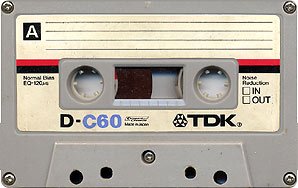Auditory Illusions
Interview with
Diana- Have you ever listened to a piece of music or speech and not heard the same thing as the other people around you? Or, others around you have understood a sound when all you've heard is noise. That's definitely happened to me! And have you ever noticed that when you first walk into a busy pub or bar, you struggle to hear the person you're with? Yet, after a few minutes, you can hear that person clearly. Well, these changes and differences in our hearing could all be called auditory illusions. And this week, Meera Senthilingam met up with Dr. Bob Carlyon from the Medical Research Council's Cognition and Brain Sciences Unit to find out how our hearing can create illusions.
 Bob - Well, I think a simple way of thinking about how we process sound is that the brain's a bit like a tape recorder, so we start off hearing a sound from the beginning, go through to the end and we pretty much get a veridical representation of what's going on. But a lot of the time, the sound coming to us is ambiguous, because the sound is often obscured by the sounds or affected by context, that sometimes, we can hear two sounds which are physically and identically the same, but perceive them as being quite different from each other.
Bob - Well, I think a simple way of thinking about how we process sound is that the brain's a bit like a tape recorder, so we start off hearing a sound from the beginning, go through to the end and we pretty much get a veridical representation of what's going on. But a lot of the time, the sound coming to us is ambiguous, because the sound is often obscured by the sounds or affected by context, that sometimes, we can hear two sounds which are physically and identically the same, but perceive them as being quite different from each other.
Meera - So these are things that we hear in our everyday lives, and they count as illusions?
Bob - That's right and sometimes we find that simply knowing what we're listening to can actually affect whether we hear something accurately or indeed at all. We can sometimes find that the percept of the sound will change over time and sometimes we find that bits of a sound are missing because there are other people talking or people clattering in the background or a plumber banging on the radiator. And we find that the brain is capable of filling in this missing information.
Meera - We're going to listen to a couple of examples of these illusions now. And the first one we're kicking off with is one that I actually helped you make earlier in the week.
Bob - That's right, yes. So, Meera sent me a recording of her saying a very important question which I think faces us all today and what we've done is we've processed this in a way which severely distorts it. So we would just like to play this to you and see if you can figure out what Meera is saying...
Meera's Distorted Question
Bob - So this is actually speech which has been processed in a way which simulates  the information available to a deaf patient with a cochlear implant. But of course, in everyday life, we hear lots of other types of distortions for example if you're trying to listen to a platform announcement in a railway station in the United Kingdom, you'll be aware that there's often huge amounts of reverberation and distortion which makes sounds really hard to listen to. Quite often, even if you get three or four chances to hear it, you don't really do any better at picking up what's being said. So, if we now play you the sound which is has not been distorted in Meera's original form:
the information available to a deaf patient with a cochlear implant. But of course, in everyday life, we hear lots of other types of distortions for example if you're trying to listen to a platform announcement in a railway station in the United Kingdom, you'll be aware that there's often huge amounts of reverberation and distortion which makes sounds really hard to listen to. Quite often, even if you get three or four chances to hear it, you don't really do any better at picking up what's being said. So, if we now play you the sound which is has not been distorted in Meera's original form:
Meera's Original Question
Meera - Okay, and then so, having listened to the real version, can we listen to the distorted one again?
Bob - Absolutely.
Meera's Distorted Question
Meera - And I bet most of our listeners now must now understand what I said in the first place and I just need to answer that, No, the Naked Scientists aren't naked, but I thought that was a good way to get the question answered out there! So, distorted speech, what does this really tell you about the way we hear things?
Bob - The distorted signal which was reaching your ears, because the information was greatly degraded, could in fact correspond to one of a number of different utterances. And so, it's quite hard for the brain to map it on to all of these individual utterances and to try and decide which is the correct one, but once you've got the right information, you're just doing a simple one-to-one mapping.
Meera - This kind of thing, it could not even matter how many times you hear it. It's really just a knowledge of what it says beforehand that can really help you to understand it?
Bob - That's right, yeah. I think what's quite interesting is when you do that, it's not that you hear the sound and then tens of seconds later, you figure out what it must have been. The percept really just pops out at you as something like a true percept and it's then really quite hard to imagine how you ever failed to understand what was being said in the first place.
Meera - And why do you think our hearing works like this?
Bob - Well, it's simply because the information with which we're presented is often highly ambiguous and distorted and in real life, we know that our brains do have lots of information, whether it's about the nature of the language we are speaking or about the familiarity we have with the person's voice or what words are likely for somebody to follow one from the other. And so, it would obviously make sense for the brain to use the information which it has. And what's quite interesting as I say is that it doesn't feel like your brain's really using that information when you're listening to these sounds and lots of other illusions we have. The sounds seem perfectly natural and convincing which is of course the way it should be. You wouldn't really want, every time that your input was a bit distorted, to think 'Ooh wasn't that clever how I managed to do that?' You want it to be natural and straightforward.
Meera - Now, another illusion you have is more about our attention and how much attention we're paying to what we're hearing.
Bob - That's right, yes. So there's an interesting sequence of sounds which is often used to study how we perceive melodies in music or how we organize things sequentially, for example tracking one person's voice in the presence of another. And the sequence is actually quite simple. It's just a repeating sequence of tones of frequencies A and B, and they go in this sort of little galloping rhythm, or repeating rhythm, A-B-A, A-B-A.
Short Sequence
Bob - Then what we find is that for most people, if you listen to that sequence repeating over and over again for a few seconds, you lose the galloping percept and it sort of splits into two streams, each of which sounds a little bit like Morse code.
Long Sequence
Meera - Yes, you really can notice the two tones and it just sounds like an engaged tone over the phone or something.
Bob - That's right, yes. And it's used in a slightly more interesting concept, by composers of polyphonic music, who want to have one instrument playing two melodies. So provided you alternate the sequences of notes, which are quite far apart in frequency, fast enough, then you can play two melodies with a single instrument.
Meera - So I guess in situations like that though, which one's the illusion and which one's correct? Or are they both just correct, and what you perceive depends on how much attention you're paying to what you're listening to?
Bob - Well, it certainly depends on how much attention you're paying because what we've shown is that if you divert somebody's attention for the first part of a longish sequence, either by playing another sound or giving them something to look at or even asking them to count backwards in threes. Then, what we find is when they start paying attention to the sounds again, it's like they've just started. In other words, they would hear the galloping rhythm even though the sequence has been on for some length of time.
Meera - Okay, so Bob, you've used all of these samples of different illusions and experimented with quite a number of people. So, what can you actually take away from this now and what have you learned about human hearing?
Bob - Well, I think there's a few points. I think one of them is that the brain can use its top down knowledge about the world and about what we're saying to affect what we hear and to deal with missing information such as when sounds are momentarily masked. We can use the way we attend to sounds to affect the way in which we hear them, and we can even use sounds which are later on in the sequence to affect the way in which we perceive sounds occurring earlier on. In many automatic speech recognition algorithms, such as you might hear when you're on the phone to your bank, these systems don't use that information and we know that they're notoriously susceptible to interfering noise or different accents. So, despite all those technological advantages, we're much better than even the best computer programmes.
- Previous Language in the Deaf Brain
- Next Why Skull Bone is Special Bone










Comments
Add a comment